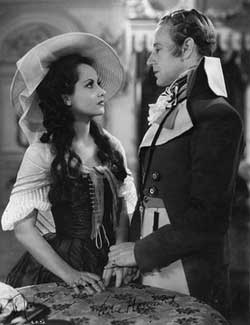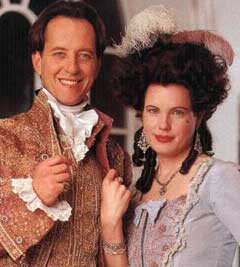The Scarlet Pimpernel
By Philip Schweier
March 5, 2013 - 12:29
Who would you say is the first super-hero? Most people might
immediately suggest Superman (1938), but it is widely accepted that he inspired
by several predecessors, including Hugo Danner, the super-human star of the
1930 novel, Gladiator, by Philip Gordon Wylie.
Okay, let’s try again: Who is the first costumed crime-fighter? Well, the
Phantom by Lee Falk first appeared in comic strip form in 1936, but before that,
Zorro leaped from the pages of Johnston McCulley’s 1919 novel, The Curse of
Capistrano.
Actually, pre-dating them all was the hero-with-a-secret-identity
known as the Scarlet Pimpernel, the public identity of an English nobleman
whose mission is to rescue French aristocrats during the Reign of Terror in
1792.
Merle Oberon (left) and Leslie Howard (right) in the 1934 version of The Scarlet Pimpernel
But a better writer than I once said, “The play is the thing,” and that is
where the Scarlet Pimpernel began – on the stage, in a play by Baroness Emmuska
Orczy. It opened in October, 1903 to less than stellar reviews at first, but a
hasty rewrite won audiences over.
The novel was published shortly afterward and its success led to numerous
sequels written over the next 35 years. Since then, the story has been adapted
for virtually every form of media.
As with many defenders of justice, the Scarlet Pimpernel is a master of
disguise, an imaginative tactician, a formidable swordsman and a daring escape
artist. He taunts his enemies by leaving behind a card showing a small flower
– a scarlet pimpernel. Like many later heroes, he hides his true identity
behind that of a witless dandy.
The original story is told through the eyes of Lady Marguerite
Blakeny, a French woman with a reputation as “the sharpest wit in Europe.” A
former actress, she fled France prior to the Revolution, to marry Sir Percival
Blakeny, a wealthy English nobleman. Lady Blakeny believes this is due to an
innocent indiscretion on her part; testimony that resulted in a French nobleman
being sent to the guillotine. Despite being duped, she bears some guilt for his
death and confesses to her husband. 
Anthony Andrews as Sir Percival Blakeny
This leads to a strain in their marriage. Sir Percy estranges himself from his
wife, developing a reputation in the eyes of the general public as a shallow
fop.
Meanwhile, the Scarlet Pimpernel has become the talk of both
England and France, as he is credited – or blamed, depending on one’s
allegiance – with helping French aristocrats (including women and
children) avoid their unjust executions
Richard E. Grant and Elizabeth McGovern
Following one such rescue, Marguerite is approached by Chauvelin, the French
envoy to England. Using her brother’s life as leverage, he coerces Lady Blakeny
into divining the Pimpernel’s true identity. Forced to choose between a
faceless legend and her brother, she reluctantly agrees.
When Lady Blakeny eventually informs her witless husband of the terrible bind
she is in, Percy promises to intervene on her brother’s behalf. When Percy
unexpectedly leaves for France, Lady Blakeny realizes he must be the Pimpernel.
She follows Percy to France to warn him of Chauvelin’s plot to trap him.
Nevertheless, through craft and guile, Sir Percy is able to outwit Chauvelin,
rescue Marguerite’s brother and escape to England.
Of course, Hollywood was quick to adapt the story to film several
times, most notably the 1934 version starring Leslie Howard and Merle Oberon. A
popular TV film was made in 1982 starring Anthony Andrews, Jane Seymour and a
younger Ian McKellen as Chauvelin. More recently, a British TV series starred
Richard E. Grant and Elizabeth McGovern.
Ian McKellan as Chauvelin
I recently read the original novel, which is relatively short, yet challenging
due to its out-dated writing style. It hasn’t the swashbuckling adventure one
might expect, but is long on intrigue. Orczy applies a number of strategic
elements which reminded me of Walter Gibson’s literary sleight-of-hand in The
Shadow stories of the 1930s.
Related Articles:
Saint-Germain Vol. 1: Le Comte des lumières
Saint-Germain, puis rouler vers l'ouest !
